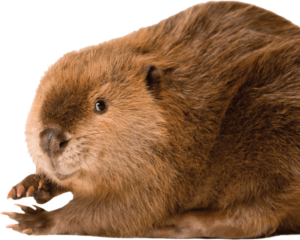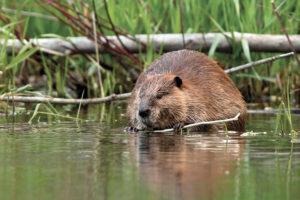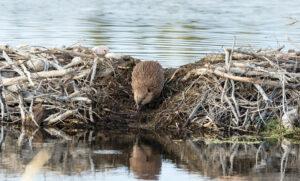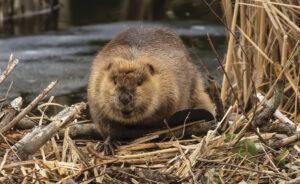There is a reason beavers are often depicted as brainy characters in children’s media. These adorable furry creatures with eccentric tails and quirky teeth actually do have bright minds when it comes to engineering. While these clever mammals’ structures clash with manmade systems at times, we can appreciate the beaver’s design and resolve conflicts that may arise with their architecture.
One of the largest rodents (averaging 30 to 50 pounds), a beaver is fairly recognizable. Beavers’ thick brown fur is smooth and sleek as they glide through water, and their unique scaly, flat tails provide balance and a way to communicate when they come across predators. Beavers slap their tails on the surface of the water to warn family members about imminent danger and startle the predator at the same time. Beavers also owe their swimming skills to their tails along with their webbed back feet. Their front paws are more dexterous for digging and handling objects. Another distinct feature is their large orange teeth. They are strengthened by the amount of iron in their enamel, which also gives them their peculiar hue. The four prominent incisors continuously grow and are sharpened as the beavers chew their food and grind their teeth together. Beavers’ diet consists mainly of trees and plants that grow in wetland areas. Their strong teeth allow them to chew the tough bark of the trees in their habitat to eat and to trim the trees as needed to build their dams. Beavers also have the amazing ability to close their ears and nostrils when they swim, and they basically have built in goggles with transparent eyelids that protect their eyes while still allowing them to see underwater. Those features come in handy, as beavers spend a significant amount of time in water. They can even stay underwater for up to fifteen minutes at a time.
If you are looking for beavers in the wild, you likely will not come across one during the day since they are mostly nocturnal, but you may be able to spot their handiwork. In addition to sustenance, wetlands with a large number of trees provide beavers with plenty of materials to build. Beavers are known for building dams, which disrupt the natural flow of water to allow them to access a den through the pool of water formed by the dam. A home on land with a secret underwater entrance is the perfect place for a beaver family to reside, as the water covered entrance protects them from predatory land animals. If you do happen to spot a beaver, its family is likely also nearby. Beavers typically mate monogamously and live together as a family with the two parents raising kits together. Although they become independent swimmers and learn to forage quickly, kits stay with their parents for about a year before building lodges of their own.
Unfortunately, where beavers build can cause some issues with a community’s infrastructure. For example, a beaver’s dam may interfere with the drainage system built specifically to prevent flooding in a certain area. Simply removing the dam may only solve the issue temporarily since beavers are quick builders that repair damage swiftly. However, there are solutions for these problems. Professionals can install devices that control the water level to bypass the dam or allow water to continue to flow through a pipe that passes through the dam. If working around the dam is not an option, it is possible to safely trap beavers, and then the dam can be removed. Beavers are hunting game, but lethal action should be the last resort for a nuisance beaver situation.
Created with specific instincts and behaviors, beavers are one of our more interesting wild community members. Although wild creatures are not tame, they often still have precise and purposeful behaviors. The next time you go exploring in an area with lots of trees and water, keep an eye out for evidence of these constructive critters. ![]()
Kimberly McMahon
Home & Yard Magazine











